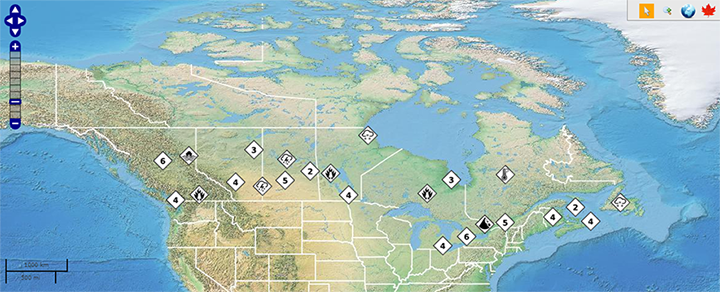Landslides and avalanches
Landslides and avalanches have resulted in more than 600 deaths in Canada since 1840 and have caused billions of dollars in damage. These mass movements of soil, rock or snow occur in all parts of the country, in mountains and flatlands, and usually without warning. Hazards include the impact of rapidly moving debris, the collapse of ground beneath a structure and secondary effects such as river damming and landslide-generated waves.
Landslides and avalanches are defined according to the size or type of debris generated, distance moved, speed of flow and underlying geology. There are eight major types that occur in Canada -- rock avalanches, debris avalanches, snow avalanches, flowslides, rockslides, rock falls, debris flows and slumps. Surprising to most, they don't only occur on a steep mountain slope. Many parts of Canada face some form of avalanche or landslide hazard.
A rock avalanche is the disintegration of a large rock mass on a mountain slope and its rapid movement downhill. The 1959 Pandemonium Creek avalanche in BC reached speeds of up to 360 km/h. In 1903, 90 million tonnes of limestone fell from Turtle Mountain and buried the coalmining town of Frank, Alberta where about 75 people died.
Prevalent only in BC, debris avalanches involve the rapid mass movements of rock originating on the slopes of volcanoes. Several have taken place in this century on the Pleistocene volcanoes of the Garibaldi Volcanic Belt in southwestern BC. They are a major hazard to development in the region.
Volume, weight and momentum make avalanches an unstoppable force
A rockslide occurs when a rock mass moves on a sliding surface but does not travel far. Two rockslides in 19th-century Québec killed a total of 77 people. Rockfalls are also very common. A rockfall occurs when a smaller rock mass breaks free and disintegrates into blocks that bounce and roll down steep slopes.
The St. Lawrence lowlands face flowslides because of the presence of leda clay. The clay becomes fluid and flows into river channels. In 1993, a flowslide at Lemieux, Ontario, blocked the South Nation River for three days. The hazard had been recognized early and the province moved the village in advance of the slide.
Slumps are a slow collapse of seemingly solid ground. The phenomenon occurs in soft rocks and sediments in many parts of Canada. Particularly prone are the ancient Cretaceous shales of the Prairies and the sediments deposited in glacial lakes following the last Ice Age. A slump in Cretaceous shales destroyed the Alaska Highway suspension bridge over the Peace River, near Fort St. John, BC in 1957.
Each year, there are reports of snow avalanches burying skiers and hikers or closing highways and rail lines. The worst occurred in March, 1910 when 62 workers were killed at Rogers Pass, BC, while digging out the railway tracks from an earlier avalanche. Defensive works, such as re-routing roads and railway tracks and triggering safe avalanches in dangerous snow packs, have helped to reduce the hazard.
For further information on specific events, see the Canadian Disaster Database.
To learn more about how individuals can get better prepared to cope with natural hazards, check out the information available from GetPrepared.
Emergency Management News Releases
-
Minister Sajjan announces funding to British Columbia for 2024 wildfires
March 6, 2025 -
The Government of Canada recognizes the 2024-2025 Emergency Management Exemplary Service Award Recipients
February 26, 2025 -
Government of Canada provides disaster recovery funding to the Northwest Territories
February 20, 2025
Emergency Management Publications and Reports
- Advancing a Pan-Canadian Civilian Response Capacity
- Building Consensus: A Governance Framework for a Nationwide Public Safety Broadband Network (PSBN)
- Government of Canada Response to the Public Order Emergency Commission Recommendations
- Advancing the Federal-Provincial-Territorial Emergency Management Strategy: Areas for Action
- Evaluation of the Initiatives to Address Post-Traumatic Stress Injuries (PTSI) Evaluation Report
- Date modified:
